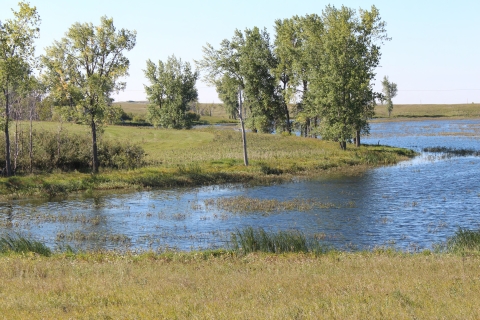About Black Terns
Black terns are a black and gray medium-sized waterbird found near wetlands across much of the U.S. Black terns use both salt water and freshwater environments, foraging for small fish in coastal wetlands, lagoons, estuaries, marshes, flooded farm fields, and other wetlands. During the breeding season, black terns nest throughout the northern U.S. and Canada on freshwater marshes, lakes, and wetlands with emergent vegetation such as cattails and bulrushes.
Black terns nest on floating vegetation only an inch or two above the water, so they are extremely susceptible to nest loss caused by changes in water level. Because of this, black tern populations fluctuate based on water and other habitat conditions since their reproductive success is driven by weather and wetland cycles. Overall, black terns typically have higher breeding numbers in wet years but are not as abundant or productive in dry years.
The largest numbers of breeding black terns can be found in the Prairie Pothole Region, where emergent wetlands are abundant.
About the Prairie Pothole Region
The Prairie Pothole Region is a huge expanse of freshwater marshes found in the upper Midwestern prairies, especially the Dakotas and across the border into the Canadian provinces of Manitoba and Saskatchewan. Depressions that were created by retreating glaciers about 10,000 years ago fill with water during spring, providing important habitat for waterfowl and many other species. Indeed, the Prairie Pothole Region is often called America’s “duck factory” since around half of the continent’s ducks breed and reproduce there.
In addition to large numbers of waterfowl, the Prairie Pothole Region is the most important area in North America for a multitude of other wetland-dependent species, as well as many grassland species. The Prairie Pothole Region provides breeding and migration stopover habitat for 36 shorebird species, including piping plovers and American avocets, and at least 40 species of waterbirds, including American white pelicans and white-faced ibis, and many species of secretive marsh birds such as Virginia rails and American bitterns. Even though the region is in the north-central U.S. and south-central Canada, it is a continental nexus for species migrating to and from the southern U.S., Mexico, Central America, and South America.
An Event of Catastrophic Proportions
In May of 2010, the Deepwater Horizon Oil Spill off the Louisiana coast became a watershed event for the entire Gulf Coast ecosystem. The Gulf of Mexico’s coastal zone and its interior watershed contain the most productive wetlands in North America. This area includes a complex array of marshes, swamps, rivers, seagrass beds, and open-water areas that are critically important to meet the life cycle requirements of many fish and wildlife species that reside, winter, or migrate throughout the Gulf region. The Gulf of Mexico is at the heart of our nation’s outdoor legacy, as it lies at the end of the Mississippi Flyway, which is used by 40% of all North American migrating waterfowl and shorebirds.
One of those species that frequents the Gulf, the black tern, was estimated to have suffered a loss of 796-1,066 individuals from the Deepwater Horizon oil spill. Listed as a USFWS Bird of Conservation Concern, it is one of our agency’s conservation priorities to address these losses and support initiatives that help the population rebound.
So How Does the Deepwater Horizon Oil Spill Relate to the Prairie Pothole Region?
Black terns use the Gulf of Mexico during migration and winter but breed elsewhere, so it made biological sense to replace those terns killed by the Deepwater Horizon oil spill with habitat conservation on their breeding grounds. The Prairie Pothole Region was a logical choice for these efforts, as it harbors up to half of the North American breeding population of black terns.
So, the Service’s Mountain Prairie Region stepped into action! The Habitat and Population Evaluation Team (HAPET), Realty program, and Partners for Fish and Wildlife Program submitted a proposal to conserve black tern breeding habitat. The Service’s HAPET office has been working with geospatial tools and other types of conservation planning for 25 years – and they had the best capacity to identify the best tern habitat for this project.
The original proposal included $6.2 million to protect 2,000 acres of wetlands and 1,000 acres of associated grasslands in perpetuity. Farmers and ranchers in North Dakota and South Dakota are the primary beneficiaries of the funding, and the Service pays cooperating landowners for voluntary conservation of wetland and grassland easements that prohibit wetlands from being drained, filled, leveled or burned, and grasslands from being converted. These grasslands are incredibly important as they help stabilize wetland water levels and increase black tern nesting success. In addition to providing habitat for black terns and many other species of wildlife, conserving these lands will reduce soil erosion and mitigate flooding in the region, as well as provide pasture and water sources for livestock.
On-the-Ground Conservation for Black Terns
This program has been wildly successful in protecting black tern nesting habitat. Nearly 4,000 acres of high-quality wetlands have been protected, almost doubling the original goal. Additionally, 4,000 acres of associated grasslands have been protected, quadrupling the original habitat conservation goal! And as the habitat acquisitions continued to grow through this program, so did the number of wetlands basins that are protected, which is great for birds into the future.
The initial survey results are in, but black tern use will continue to be monitored in future years. In 2021, there were 33 black terns observed using protected parcels. In 2022, HAPET staff observed 215 black terns, and 128 black terns were observed in 2023. However, this past year in 2024, there were 362 black terns documented on wetlands protected under this initiative!
This approach to restore black tern populations was incredibly innovative, included multiple Service programs, and was developed and led by some of the most experienced and successful conservation planning and delivery programs the Service has. This project spanned more 1600 miles across the entire Mississippi Flyway and part of the Central Flyway and is truly a comprehensive approach to restoring not only black terns, but many other species that will benefit from this long-term habitat conservation.








